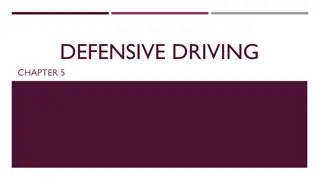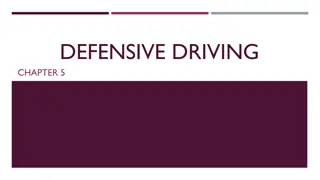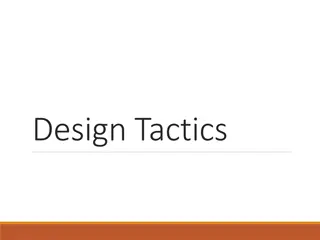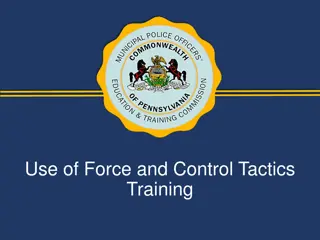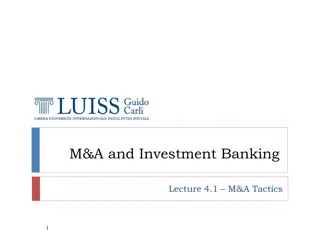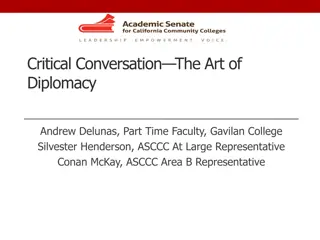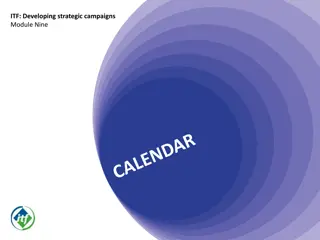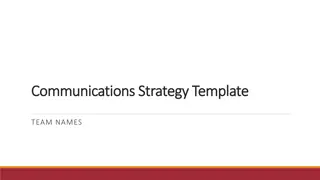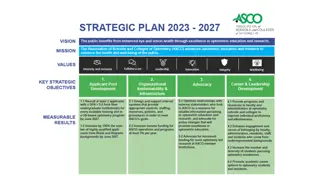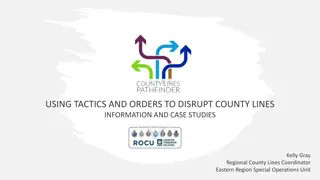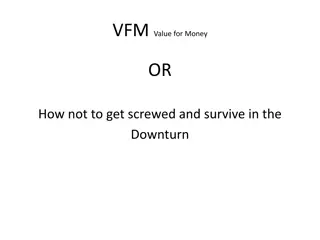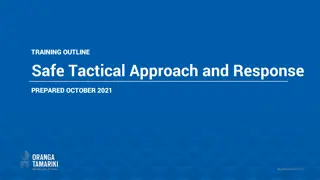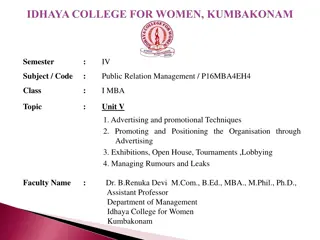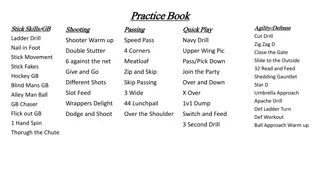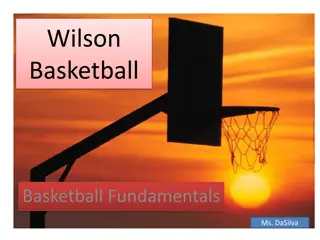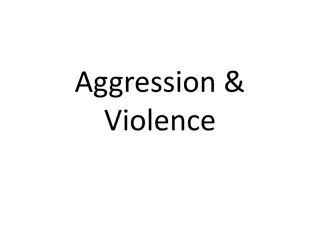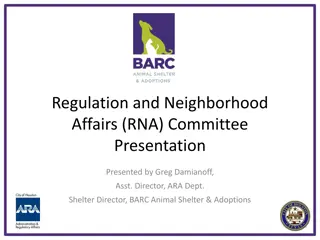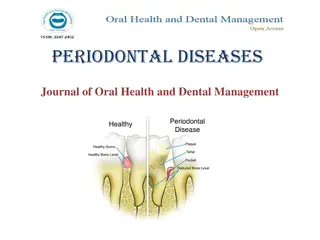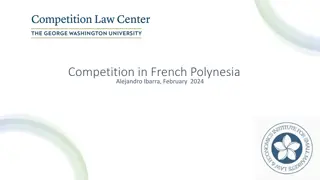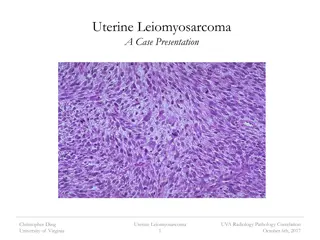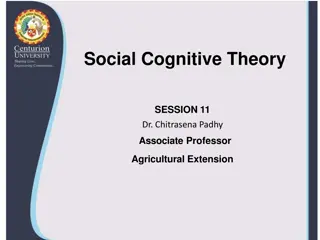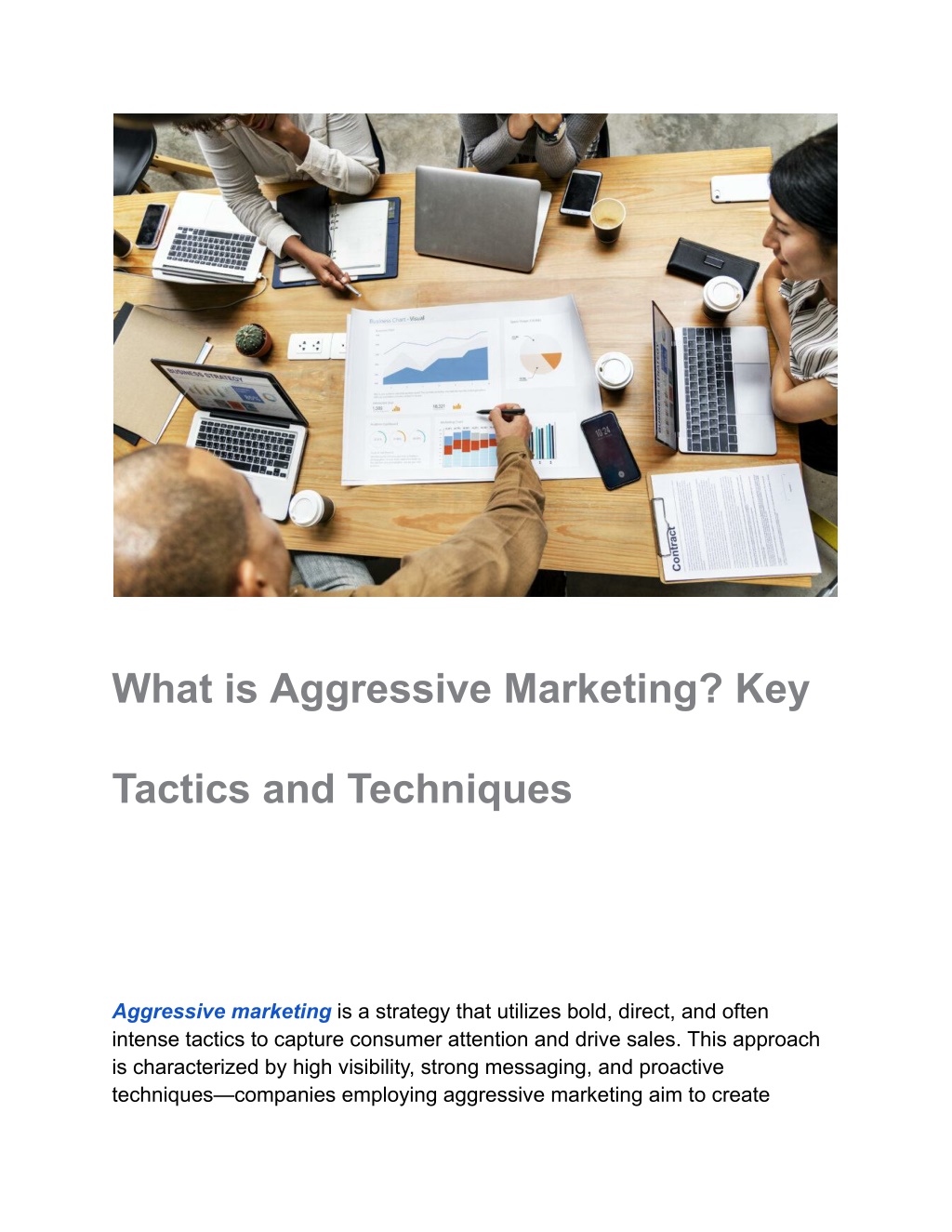
What is Aggressive Marketing_ Key Tactics and Techniques
Aggressive marketing is a bold and assertive approach that businesses use to gain a competitive edge. It involves various tactics designed to quickly capture attention, dominate market share, and boost sales. This strategy can be highly effective for
Download Presentation

Please find below an Image/Link to download the presentation.
The content on the website is provided AS IS for your information and personal use only. It may not be sold, licensed, or shared on other websites without obtaining consent from the author. Download presentation by click this link. If you encounter any issues during the download, it is possible that the publisher has removed the file from their server.
E N D
Presentation Transcript
What is Aggressive Marketing? Key Tactics and Techniques Aggressive marketing is a strategy that utilizes bold, direct, and often intense tactics to capture consumer attention and drive sales. This approach is characterized by high visibility, strong messaging, and proactive techniques companies employing aggressive marketing aim to create
immediate and strong impacts on their target audience through various means. Direct Response Campaigns: Focus on eliciting quick customer reactions. High-Frequency Advertising: Saturates multiple channels with repeated messages. Flash Sales and Limited-Time Offers: Urgency-driven promotions that compel immediate purchases. Competitive Advertising: Directly targets competitors weaknesses or highlights comparative strengths. These methods foster an assertive market presence. Aggressive Marketing Aggressive marketing refers to a hard-hitting approach aimed at quickly increasing market share, brand awareness, and sales. It utilizes bold techniques to captivate the target audience and outperform competitors. Key Characteristics: High-Intensity Promotions: Frequent advertising and promotional campaigns. Competitive Pricing: Offering substantial discounts or undercutting competitors prices. Key Performance Indicators (KPIs): Focusing on short-term gains such as lead generation and conversion rates. Direct Engagement: Immediate and direct communication channels, like emails, calls, and social media. Aggressive marketing often involves data-driven strategies to optimize touchpoints and ensure maximum reach and impact. It is suitable for various industries, including retail, technology, and consumer goods.
Key Traits of Aggressive Marketing Strategies Aggressive marketing strategies encompass several distinct characteristics that set them apart. These strategies often focus on high visibility, competitive tactics, and bold actions to achieve rapid market penetration and brand recognition. High-Visibility Campaigns Intensive Advertising: Utilize multiple platforms like TV, social media, and print. Frequent Promotions: Offering significant discounts and limited-time offers. Competitive Tactics Market Domination: Aiming to outperform competitors through superior offerings. Price Wars: Undercutting competitors prices to attract price-sensitive consumers. Bold Actions Innovative Approaches: Utilizing cutting-edge technology and marketing methods. Risk-Taking: Willingness to try unconventional tactics that may not always guarantee success. Aggressive marketing requires a proactive approach to identifying opportunities and seizing them rapidly. The Psychology Behind Aggressive Marketing
Aggressive marketing utilizes psychological principles to influence consumer behavior. Understanding human emotions and cognitive biases is critical. Scarcity: Creates a sense of urgency, prompting quick decisions. Social Proof: Showcases endorsements or testimonials to build trust. Reciprocity: Offers free items or services, encouraging reciprocation. Authority: Utilizes expert opinions or certifications for credibility. Consistency: Engages customers episodically to maintain brand presence. These tactics tap into fundamental psychological triggers, driving strong reactions and often resulting in high conversion rates. The interplay of these elements forms the cornerstone of effective aggressive marketing strategies. Benefits of Aggressive Marketing Aggressive marketing offers several advantages, allowing businesses to achieve rapid growth and market penetration. Key benefits include: Increased Brand Visibility: Aggressive marketing campaigns raise brand awareness quickly, making the brand more recognizable to a broader audience. Higher Sales Volume: By capturing the attention of potential customers, aggressive marketing often results in a substantial increase in sales. Competitive Edge: Firms can outpace competitors by setting market trends and establishing leadership within their industry. Customer Acquisition: High-impact strategies attract new customers, expanding the business s customer base. Profit Margins: Proactive approaches can lead to improved profit margins due to higher product demand and sales. Risks and Drawbacks of Aggressive Marketing
Aggressive marketing, while effective in driving short-term sales, poses several risks and drawbacks. Customer Alienation: Continual pressure may lead to customer irritation and mistrust. Brand Damage: Overaggressive tactics can tarnish a brand s reputation. Legal Issues: Not adhering to regulations can result in fines or legal action. High Costs: Aggressive campaigns often require significant financial investment. Short-Term Focus: Balancing immediate gains against long-term relationships can be challenging. Negative Publicity: Poorly executed strategies may attract adverse media attention. Employee Burnout: High-pressure environments can lead to staff dissatisfaction. Impact of Aggressive Marketing on Brand Perception Aggressive marketing, while effective in driving immediate sales, can significantly impact brand perception. Consumers may view aggressive tactics as intrusive or manipulative, leading to distrust. Positive Impacts: Increased awareness: Persistent messaging can enhance brand visibility. Enhanced positioning: A strong, dominant market stance can distinguish a brand. Negative Impacts: Consumer irritation: Overly persistent strategies can frustrate customers.
Brand fatigue: Saturation from constant exposure can lessen brand appeal. Trust erosion: Perceived pressure tactics can diminish consumer confidence. Careful balance is essential to utilize benefits without alienating the audience. Critical Techniques in Aggressive Marketing Aggressive marketing is a bold approach that employs a variety of high-impact strategies to not only capture the attention of potential customers but also drive them toward making swift purchasing decisions. This method is particularly effective in competitive markets where standing out is crucial. To master aggressive marketing, businesses must implement the following critical techniques: 1. Targeted Advertising: Precision Targeting: Instead of casting a wide net, aggressive marketing zeroes in on specific demographics that are most likely to convert. This involves creating highly personalized messages that resonate with the audience s unique needs, preferences, and behaviors. By using data-driven insights, marketers can segment their audience based on factors such as age, gender, location, interests, and purchasing habits, ensuring that every ad speaks directly to the intended recipient. Dynamic Ad Content: Tailoring ad content dynamically based on real-time user data allows for even more precise targeting. For example, an e-commerce site might show different product ads to users depending on their browsing history, making the advertising experience more relevant and engaging. 2. High-Frequency Promotions: Consistent Exposure: Repetition is key in aggressive marketing. By consistently exposing the target audience to promotional
content across various channels, such as display ads, email marketing, and social media, businesses can significantly increase brand recall and influence purchase decisions. High-frequency promotions ensure that your brand remains top-of-mind, especially during key decision-making moments. Seasonal and Event-Based Campaigns: Running frequent promotions during peak seasons or around specific events can create a sense of urgency and capitalize on the natural increase in consumer spending during these times. 3. Compelling Offers: Creating Urgency: Aggressive marketing often relies on the power of time-sensitive deals to create a sense of urgency. Limited-time discounts, flash sales, and exclusive offers can prompt potential customers to act quickly before the opportunity passes. These offers not only attract new customers but also encourage repeat business by rewarding loyalty with special deals. Value Proposition: To make offers more compelling, focus on the unique value proposition of your product or service. Highlight what sets you apart from competitors, whether it s superior quality, innovative features, or exceptional customer service. 4. Influencer Partnerships: Leveraging Credibility: Partnering with influencers who align with your brand can significantly expand your reach and enhance credibility. Influencers have established trust with their followers, making their endorsements more impactful than traditional advertising. By collaborating with influencers who have a strong connection with your target audience, you can tap into their influence to boost brand awareness and drive conversions. Diverse Influencer Tiers: Consider working with a mix of macro, micro, and nano influencers to maximize reach and engagement. While macro-influencers offer a broad audience, micro and nano influencers often have more engaged followers, leading to higher conversion rates. 5. Analytics Utilization: Data-Driven Decision-Making: In aggressive marketing, every move should be backed by data. By leveraging analytics tools,
businesses can gain deep insights into customer behavior, campaign performance, and overall market trends. This data allows marketers to refine their strategies continuously, optimize ad spend, and ensure that their efforts are driving the desired results. Predictive Analytics: Implementing predictive analytics can help forecast future trends and customer behaviors, allowing for proactive adjustments to marketing strategies. This foresight can give businesses a competitive edge by enabling them to anticipate and meet customer needs before the competition. 6. Cross-Channel Marketing: Integrated Campaigns: A hallmark of aggressive marketing is the seamless integration of multiple marketing channels. By creating cohesive campaigns that span across various platforms such as social media, email, search engines, and offline media businesses can ensure a consistent brand message while reaching a broader audience. Cross-channel marketing not only amplifies your brand presence but also increases the chances of engaging potential customers at different touchpoints along their buyer s journey. Unified Customer Experience: Ensure that messaging, visuals, and offers are consistent across all channels to provide a unified experience. This consistency reinforces brand recognition and builds trust with the audience. 7. Customer Retargeting: Re-engagement Strategies: Retargeting is a powerful tool in aggressive marketing, allowing businesses to re-engage with previous visitors who did not convert on their initial visit. By serving personalized ads to these individuals, businesses can remind them of the products or services they were interested in, nudging them closer to making a purchase. This technique is particularly effective for capturing potential customers who may have abandoned their carts or hesitated at the final stages of the buying process. Dynamic Retargeting: Use dynamic retargeting ads that display the exact products or services a user viewed on your site. This
personalized approach can significantly increase the chances of conversion by addressing the specific interests of the customer. 8. Customer Loyalty Programs: Building Long-Term Relationships: While aggressive marketing often focuses on acquiring new customers, it s equally important to retain existing ones. Implementing customer loyalty programs can encourage repeat business and foster brand loyalty. Offer rewards, discounts, or exclusive access to members, making them feel valued and incentivizing continued engagement with your brand. Personalized Loyalty Rewards: Tailor rewards based on customer preferences and purchase history to create a more personalized and effective loyalty program. This can lead to increased customer satisfaction and long-term loyalty. Successful Aggressive Marketing Campaigns Successful aggressive marketing campaigns often leverage bold, high-impact strategies to capture attention and drive sales. Notable examples include: 1. Apple s Product Launch Events: Apple s aggressive launch strategies generate immense media coverage. Carefully orchestrated events build anticipation and urgency. 2. Nike s Just Do It Campaign: Leveraged powerful imagery and motivational messaging. Created a sense of community and aspiration. 3. Coca-Cola s Personalized Cans: Customized product packaging with consumer names. Engaged customers through social media sharing. 4. Red Bull s Extreme Stunts: Sponsored extreme sports events. Promoted content intensively across platforms.
Legality and Ethical Considerations Privacy Laws: Adherence to regulations like GDPR and CCPA is essential when collecting and using consumer data. Spam Regulations: All email and SMS campaigns must comply with CAN-SPAM and other anti-spam laws. Fair Competition: Practices should not unfairly disadvantage competitors or deceive customers. Ethical considerations should also guide marketing tactics: Transparency: Being clear about products and services builds trust. Respect for Consumers: Prioritize customer needs and avoid exploitative tactics. Social Responsibility: Promote sustainability and ethical consumption. Measuring the Effectiveness of Aggressive Marketing Assessing the effectiveness of aggressive marketing requires meticulous tracking and analysis of key metrics. Primary indicators include: Sales Performance: Monitor changes in sales volume and revenue. Customer Acquisition Cost (CAC): Calculate the cost to acquire a new customer. Return on Investment (ROI): Evaluate the financial return compared to marketing expenditure. Market Penetration Rates: Measure the extent of market share. Brand Awareness: Use surveys and social media metrics to gauge visibility. Effective measurement tools like Google Analytics, CRM systems, and social media dashboards can provide valuable insights. Reliable data is essential for refining strategies and ensuring sustainable growth.
Balancing Aggressive Marketing with Consumer Trust Aggressive marketing can boost short-term sales but risks eroding consumer trust. Companies must carefully balance these tactics to maintain long-term credibility. Key considerations include: Transparency: Communicate the motives behind marketing efforts. Respect for Privacy: Never exploit consumer data without explicit consent. Authenticity: Ensure that marketing messages align with the company s values and product offerings. Feedback Mechanisms: Establish channels for consumer feedback to address concerns promptly. Regular Audits: Conduct periodic reviews to avoid overstepping ethical boundaries. By maintaining this balance, businesses can utilize aggressive marketing while fostering and retaining consumer trust. Future Trends in Aggressive Marketing Emerging trends in aggressive marketing indicate a shift towards data-driven techniques and AI-driven analytics. Companies are increasingly leveraging: Personalization: Using customer data to tailor marketing messages precisely. Real-time engagement: Utilizing AI and chatbots for instant customer interaction. Omni-channel marketing: Ensuring consistent messages across multiple platforms. Ethical considerations: Balancing aggressive tactics with responsible marketing.
Influencer partnerships: Enhancing authenticity through credible influencers. Content saturation: Overcoming audience fatigue with innovative content. Privacy concerns: Navigating regulations and consumer privacy expectations. These trends highlight the evolving landscape of aggressive marketing, driven by technology and consumer behavior shifts. Key Takeaways Definition: Aggressive marketing involves assertive, bold tactics aimed at quickly capturing market share. Target Audience: A key focus is identifying and understanding the target audience for precision in messaging. Psychological Tactics: Creating a sense of urgency and appealing to emotions can drive faster decisions. Competitor Analysis: Analyzing competitors to find weaknesses and opportunities is crucial. Multichannel Approach: Utilizing multiple marketing channels, including digital, social, and traditional media. Personalization: Customized marketing content tailored to individual consumer preferences increases engagement. Consistent Follow-up: Regularly follow up with leads to convert them into customers. Data Analytics: Leveraging data to measure the effectiveness of campaigns and optimize strategies.

